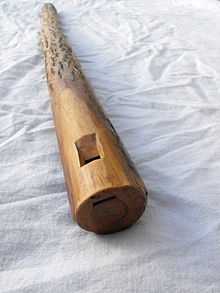Overtone flute

An overtone flute is a type of a flute that is designed to play in the upper harmonics, typically well above the two or three harmonics that are the practical limit for most woodwind instruments.
Overtone flutes may be considered simple tubes lacking tone holes,[2] or relatively few tone holes for a woodwind instrument.[3] They rely on their ability to play high into the overtone series in order to play melodies. One series of harmonics is achieved by overblowing with the end of the tube open and another is achieved with the end closed.[2] This means that most overtone flutes are limited to producing only those notes from a natural scale.
Overtone flute tubes typically have relatively long resonating chamber compared it its diameter or cross sectional area, which encourages the instrument to resonate in the higher harmonics. This also makes it either difficult to play or very quiet when attempting to play the instrument in the first harmonic.
Examples
- Kalyuka - Russian and Ukrainian overtone flute
- Willow flute - Scandinavian flute
- Fujara - a Slovakian flute
- Koncovka - another Slovakian flute
- Choctaw overtone flute[4]
See also
- Natural trumpet - similar brass overtone instrument
References
- ↑ "FAQ about: Koncovka (overtone flute)". Folkart Slovakia.
- ↑ 2.0 2.1 Maclagan, Susan J. (2009). A Dictionary for the Modern Flutist, p.124. ISBN 9780810867284.
- ↑ Perret, Daniel (2005). Roots of Musicality: Music Therapy and Personal Development, p.161. ISBN 9781846420900.
- ↑ Clint Goss (2012). "The Choctaw Overtone Flute / Indigenous North American Flutes". Flutopedia. Retrieved 2012-02-22.
External links
- Overtone-Flute.com - pictures, sounds and information
- Kalyuka - Russian overtone flute - videos, sounds and information